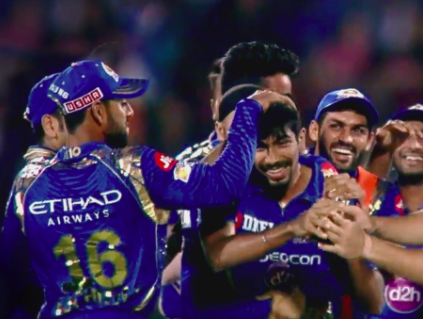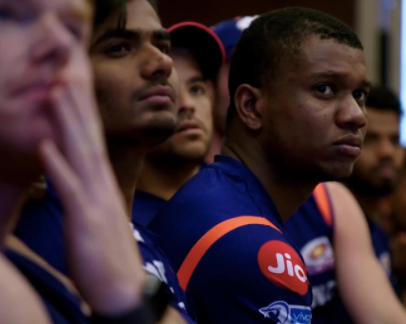My favourite sports documentary – Cricket Fever: Mumbai Indians gives us a glimpse of a new India
There’s a certain Tiger King quality to this eight-part Netflix documentary, whose undercurrents are of India’s emergence as a global economic powerhouse, writes Vithushan Ehantharajah


Any great documentary should transcend its subject matter. In the case of Cricket Fever: Mumbai Indians, the subject matter is the Indian Premier League and its most successful franchise.
Since its inception in 2008, the IPL has combined India’s obsession with cricket, the popularity of Twenty20 – the shortest format – and Bollywood glitz to create a global behemoth. Perhaps naturally, it would be a team hosted in Mumbai, a dynamic city boasting a combined wealth of $950bn that would rule this roost with four titles.
But that you may finish the eight episodes and wonder about the influence of the owners on team selection, the relentless demands of the competition and the disparity of wealth that seems particularly stark in a city where half the population live in poverty is purely by accident.
Indeed, the undercurrents of the documentary are of India’s emergence as a powerhouse in the global economy. The growth of its middle class, in particular, has come in line with packed stands filled with parents and children.
This rise of new money is perfectly encapsulated by the Ambani family, which owns the Mumbai Indians. Billionaire Mukesh Ambani, the second richest man in Asia, is the chairman and managing director of Reliance Industries Limited. But the main Ambani representation comes in the form of his wife, Nita, and son, Akash.
Alexander Edgington, the executive vice-president of Condé Nast Entertainment, the production company behind Cricket Fever, knew what he was doing by selecting this particular team. The Ambanis have been very visible owners, walking around the changing room, dugouts and even on the field, at times to a fault. The scale of their wealth and the pull they have over their side is best highlighted in the team-bonding exercise of a treasure hunt through their palatial 400,000-square-foot residence that towers over the Mumbai skyline.
In many ways, both Nita and Akash are the stars of the show, though “stars” is doing some heavy lifting there. There’s a certain Tiger King quality to their cameos – this is as much about them and their lives as it is about the cricket.
The chances to see the inner workings of a team full of superstars, such as India’s Rohit Sharma and Hardik Pandya, and West Indies’ Kieron Pollard (widely regarded as one of the greatest T20 all-rounders), are interrupted by the latest underwhelming Ambani team talk. You can only admire the players for being able to keep a straight face when defeat after defeat is followed by cringe-worthy calls to action from the owners, who look and feel out of place in the sanctity of the changing room.
That’s not to say they don’t mean well, or that they detract from the wider story of a franchise learning to deal with failure. The season charts the team’s 2018 season, in which they finish outside the play-off spots, despite having sealed their third IPL win in 2017.
The team tensions rebuild, and the pressures from every direction heaped on its established pros and newcomers are particularly evident. Perhaps they are most pronounced in the fluctuating moods of their coach, former Sri Lanka legend Mahela Jayawardene, whose 20-year playing career was built on class and composure.
If you are a cricket fan, there is plenty to sink your teeth into. The game has turned secretive from its almost open-door policy of the Eighties, in part because of increased and intrusive media scrutiny – and so the chance to go behind the curtain at such an exclusive competition is tantalising.

The boardroom scenes are new hat when it comes to cricket, with the series opening amid intense discussions on who and how they plan on recruiting new talent at the upcoming IPL auction. Even if you are a purist, perhaps you’ll have your mind changed by the real toil involved in the shortest form of cricket, as you watch 19-year old Ishan Kishan wrestle with his place in this world as his output dwindles. It is at odds with the perception that T20 is “a bit of a laugh”, or that precocious Indian batsmen must have things their own way.
One particularly striking moment is when overseas batsman Evin Lewis is forced to play with a wrist injury. Even if you’re unfamiliar with the whims of cricket, you’ll see a problem there.
It highlights the cold-hearted nature of these competitions. The only concern with their allotted five foreign players per squad comes in the months of competition. Outside of that, the onus is on the individual to make himself right. Any injuries sustained during the tournament will be treated during the tournament. After that, the risk and the responsibility is carried by the country or the team to whom a player is contracted.
What results is an unsavoury ecosystem whereby players can be discarded like the toys of an impatient child. Lewis refusing to take a risk would have been a black mark against him. The power dynamic could not be more apparent. He is given the choice but, really, he must do as they say.
When he unsurprisingly fails, plied with injections yet still wincing with every swing of the bat, the sense is that he has let Mumbai Indians down. Not the other way around.
There is a similar lack of sympathy when fast bowler Mustafizur Rahman is berated for not working as hard as he should. The scene is actually teed up in Rahman’s favour: a kid from Bangladesh thrust into the bright lights far too soon because of his talents, trying to make his way at the highest level from humble beginnings. The dressing down is in English, and so a translator is on hand to make sure the message gets through to Rahman, and for all the world, you hope the choice words are omitted.
It is more peculiar still that these two scenes made the final cut.
Mumbai Indians maintained creative control of the process, and while it has been revealed that certain aspects of filming will never see the light of day, some are kept in despite not painting a healthy picture of the team environment. Perhaps they think it shows ruthlessness. That this is what it takes to become champions.
But really, it gives us a glimpse of a new India. A country forced to be subservient for so long has emerged from the shadows and taken back what is theirs with the bravado of a superpower.
Wealth and competitiveness walk hand in hand through this series. Even when the results on the pitch are not up to scratch, the team’s sense of worth never wavers. It is reflective of a strong sense of nationalism among younger generations throughout the country – of steadfast belief.
The IPL, Mumbai Indians, and the Ambanis are perhaps the best examples of that.
Join our commenting forum
Join thought-provoking conversations, follow other Independent readers and see their replies
Comments